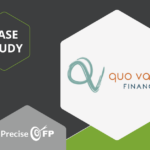Being a financial advisor comes with its own set of challenges, and managing a multitude of clients is just the tip of the iceberg. At any given moment, a financial advisor typically juggles more than a dozen open tabs on their internet browser to accommodate the array of essential technologies at their disposal. Whether it’s data aggregation tools, custodian platforms, financial planning software, CRM systems, email platforms, marketing software, data gathering tools, document storage solutions, and much more, the modern advisor’s tech stack is a complex ecosystem.
The key to thriving in this ever-evolving landscape is to ensure that your tech stack remains agile, constantly adapting to the evolving needs of clients and regulatory bodies alike. It’s widely acknowledged that technology plays a pivotal role in any wealth management practice, enabling advisors to efficiently manage portfolios, track performance, and deliver exceptional results to their clients.
Yet, amid the undeniable importance of technology, there remains a learning curve among Registered Investment Advisors (RIAs) when it comes to determining which technologies are truly effective. A staggering 94% of wealth management professionals cite inefficient technology integrations as a limiting factor to their productivity.
Despite the significant strides made in the financial services industry, there’s still ample room for improvement in how technology is harnessed at every level. To empower RIAs to stay ahead of the curve, let’s delve into the crucial process of evaluating your RIA tech stack efficiently.
What Technology Do I Need to Evaluate?
The first and most important step in evaluating your RIA tech stack is to organize it. After all, you can hardly evaluate something you’re unaware of. It’s surprisingly easy to purchase more technology tools over time, leading to technology overwhelm and, frankly, overspending.
There are five main components of any wealth management firm’s technology stack. While you can organize it in any way you prefer, we’ve found it helpful to break it down like this:
- Portfolio Management
- Investment Tools
- Communications
- Back Office Operations
- Custodians, CRM and Performance Reporting
Listing your tools in one place can help you take a step back and evaluate where you might be overinvesting or underinvesting. Now that you’ve got all the tech organized and in one place, it’s time to evaluate each in greater detail.
Does My Tech Help Me Scale or Introduce More Complexity?
Every wealth management firm’s approach to technology should be uniquely tailored to its business goals and objectives. Although most will serve the same overall objectives with clients, your firm may have different goals and processes than the next.
Indeed, the core of this exercise — evaluating your tech stack’s effectiveness — will depend on contrasting your technology’s purpose with your overall business strategy. If your business objectives aren’t clear, your technology’s objectives will be just as murky.
First, outline a strategic plan that keeps technology in mind. Here are a few questions to get started:
- What do your advisors need to better serve clients?
- What are your firm’s goals, and how can technology enable them?
- In three, five, or 10 years from now, what specific ways do you want your technology investments to have paid off?
- What features or functions are you hoping to add to your firm’s offerings to stay competitive, and how can technology solutions make those happen?
Next, take the outline of your existing technology from the previous step and compare it against those objectives. You should have a list of existing technologies compared with your business strategy. Take note: Are there any gaps? Is there any technology oversaturation?
Is My Tech Agile, Updated and Compliant?
Now that you’ve organized your financial software, business goals, and objectives and compared and contrasted the two, you’re in a great position to evaluate. Which software is essential to your business? What capabilities are you lacking? And most importantly, which essential technologies need to be updated or replaced?
One of the most crucial elements of any tech evaluation is determining whether the technology you have can scale and grow with your business, as well as whether it meets essential business requirements.
Since you now have a good idea of what is and isn’t working, here are a few questions to help evaluate new and existing technologies alike:
- Does your tech stack introduce redundancies? If technology is starting to hinder your performance rather than help it, that’s a good indicator that something is off.
- Is your tech stack personalized to your firm’s strategy and needs?
- Is your technology compliant and secure against cyber threats?
From there, you should have a good idea of how to move forward. Eliminating technology that no longer serves your goals helps provide a competitive experience to customers, improve your bottom line by removing redundant spending, and reduce back-office complexity.
PreciseFP has earned its place as a leading data-gathering and client engagement solution for a compelling reason. Offering seamless integrations that automatically map over 100 fields and boasting an extensive pre-built library of over 40 form templates, it stands as a plug-and-play solution highly praised within the financial advisor community. Start your free trial today.







